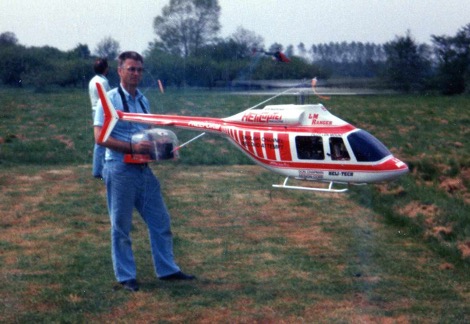
Crucial to the success of any business is keeping it in the mind of potential customers.
In the UK, being the first to cross the channel, whether by swimming or flying, has always guaranteed press coverage. I had read in one of the modelling magazines that the model manufacturer Graupner had claimed to have crossed the channel with a radio-controlled helicopter but that it had been badly damaged on landing.
On further investigation I found out that to gain the title ‘first’, the model still had to be flyable at the end of the challenge and because this wasn’t the case with the Graupner attempt, the title was still available. So I decided that I would go for it.
It took three months to design and build two models for the challenge. The biggest problem facing the design was to keep the model under 6kg in weight including fuel, as this was the limit placed by UK airspace regulations for radio control models. To help achieve this I made the mechanics out of titanium and magnesium, which then allowed a fuel payload of 3⁄4 gallon. This amount of fuel was sufficient to get the model across the channel, provided I kept up a flying speed of around 45-60kph.
In order to ensure press coverage I got in contact with Colin Cameron Tough, editor of the high quality ‘International Helicopter’ magazine. He agreed that they would not only cover the attempt in the magazine, but they would also supply the full-size helicopters needed. True to his word, Colin arranged for two helicopters – one would carry me from where I would fly the model and one from which photos could be taken of the attempt.



The trip was uneventful until we got 550 metres from the landing zone when I noticed that the tail rotor had stopped indicating that the engine had also stopped. To get the ‘first’ title, the rules stated that I had to land within 60 metres of pre-arranged landing spot, which meant that I had to auto rotate-glide the model for at least 500 metres. I was flying at around 240 metres in height, but I knew in my heart I knew that I wasn’t going to make it. In front I could see a cornfield so I chose to stretch the glide for as far as I could and land in the field. Fortunately the sun had come out and so I could see the shadow of the model moving closer to the actual model, which helped me to judge how high it was above the ground. As the two met I put on collective pitch and hoped it was a soft landing. The observer who was monitoring the attempt said he wasn’t sure that it had landed inside the required landing zone, so he was going to measure it. Fortunately it was just inside the limit by the small margin of 3 metres!
To get the title, all I had to do now was to make sure that the model wasn’t damaged. With fear and trepidation I pulled it out of the corn. There was a small amount of fuel left in the tank (the clunk on the fuel pipe hadn’t picked up all of the liquid due to the forward lean attitude of the model in flight). To my delight the engine started and I brought the model up into a steady hover. The title was mine.